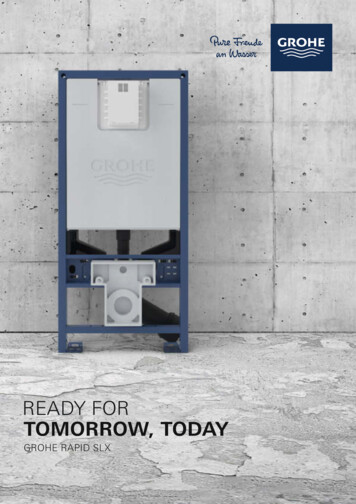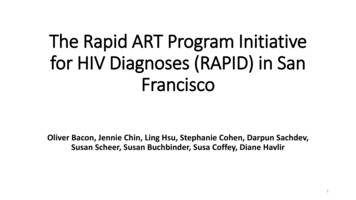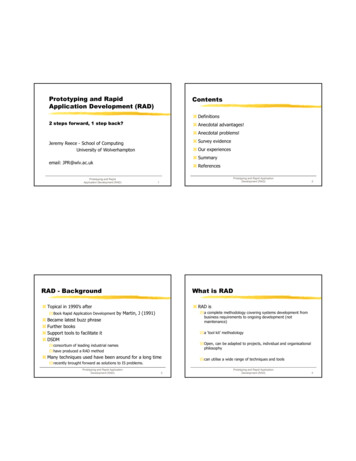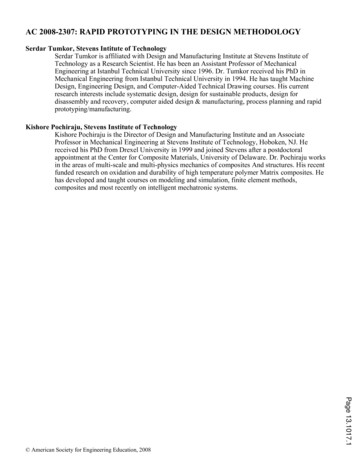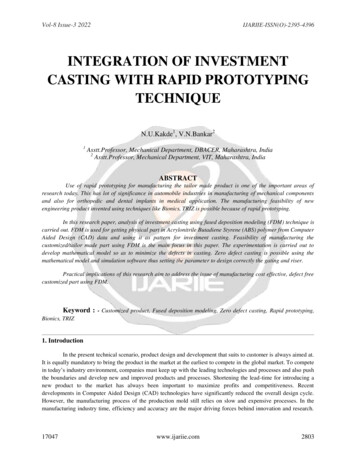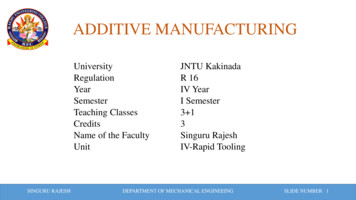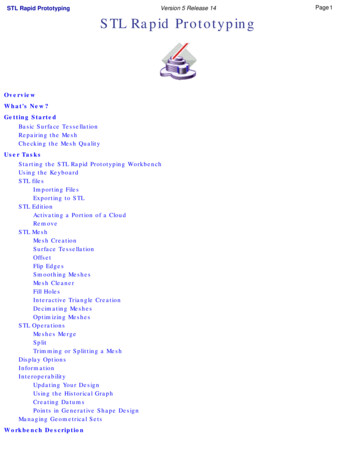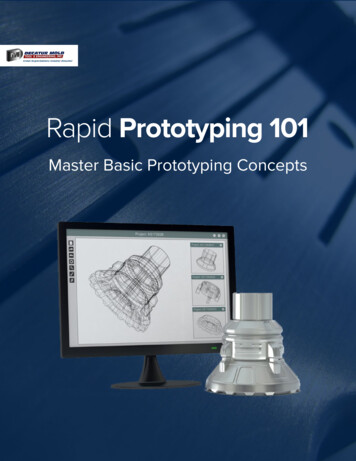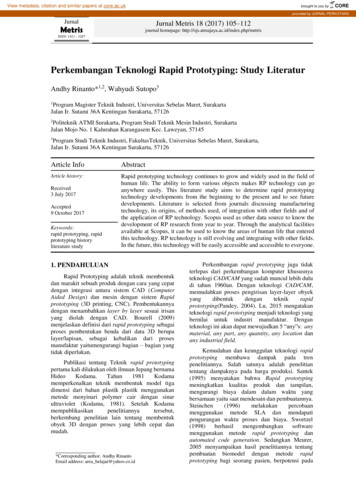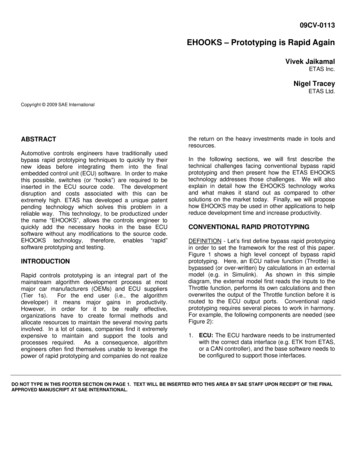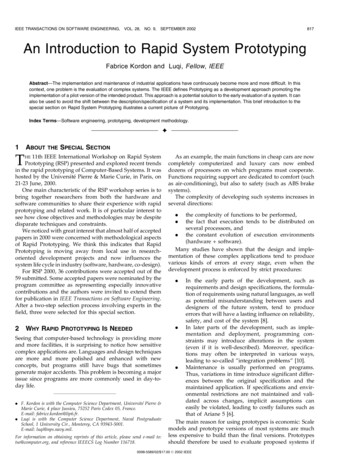
Transcription
IEEE TRANSACTIONS ON SOFTWARE ENGINEERING,VOL. 28,NO. 9,SEPTEMBER 2002817An Introduction to Rapid System PrototypingFabrice Kordon and Luqi, Fellow, IEEEAbstract—The implementation and maintenance of industrial applications have continuously become more and more difficult. In thiscontext, one problem is the evaluation of complex systems. The IEEE defines Prototyping as a development approach promoting theimplementation of a pilot version of the intended product. This approach is a potential solution to the early evaluation of a system. It canalso be used to avoid the shift between the description/specification of a system and its implementation. This brief introduction to thespecial section on Rapid System Prototyping illustrates a current picture of Prototyping.Index Terms—Software engineering, prototyping, development methodology.æ1ABOUTTHESPECIAL SECTIONTHE 11th IEEE International Workshop on Rapid SystemPrototyping (RSP) presented and explored recent trendsin the rapid prototyping of Computer-Based Systems. It washosted by the Université Pierre & Marie Curie, in Paris, on21-23 June, 2000.One main characteristic of the RSP workshop series is tobring together researchers from both the hardware andsoftware communities to share their experience with rapidprototyping and related work. It is of particular interest tosee how close objectives and methodologies may be despitedisparate techniques and constraints.We noticed with great interest that almost half of acceptedpapers in 2000 were concerned with methodological aspectsof Rapid Prototyping. We think this indicates that RapidPrototyping is moving away from local use in researchoriented development projects and now influences thesystem life cycle in industry (software, hardware, co-design).For RSP 2000, 36 contributions were accepted out of the59 submitted. Some accepted papers were nominated by theprogram committee as representing especially innovativecontributions and the authors were invited to extend themfor publication in IEEE Transactions on Software Engineering.After a two-step selection process involving experts in thefield, three were selected for this special section.2WHY RAPID PROTOTYPING IS NEEDEDSeeing that computer-based technology is providing moreand more facilities, it is surprising to notice how sensitivecomplex applications are. Languages and design techniquesare more and more polished and enhanced with newconcepts, but programs still have bugs that sometimesgenerate major accidents. This problem is becoming a majorissue since programs are more commonly used in day-today life. F. Kordon is with the Computer Science Department, Université Pierre &Marie Curie, 4 place Jussieu, 75252 Paris Cedex 05, France.E-mail: fabrice.kordon@lip6.fr. Luqi is with the Computer Science Department, Naval PostgraduateSchool, 1 University Cir., Monterey, CA 93943-5001.E-mail: luqi@nps.navy.mil.For information on obtaining reprints of this article, please send e-mail to:tse@computer.org, and reference IEEECS Log Number 116718.As an example, the main functions in cheap cars are nowcompletely computerized and luxury cars now embeddozens of processors on which programs must cooperate.Functions requiring support are dedicated to comfort (suchas air-conditioning), but also to safety (such as ABS brakesystems).The complexity of developing such systems increases inseveral directions:the complexity of functions to be performed,the fact that execution tends to be distributed onseveral processors, and. the constant evolution of execution environments(hardware software).Many studies have shown that the design and implementation of these complex applications tend to producevarious kinds of errors at every stage, even when thedevelopment process is enforced by strict procedures:.In the early parts of the development, such asrequirements and design specifications, the formulation of requirements using natural languages, as wellas potential misunderstanding between users anddesigners of the future system, tend to produceerrors that will have a lasting influence on reliability,safety, and cost of the system [8]. In later parts of the development, such as implementation and deployment, programming constraints may introduce alterations in the system(even if it is well-described). Moreover, specifications may often be interpreted in various ways,leading to so-called ”integration problems” [10]. Maintenance is usually performed on programs.Thus, variations in time introduce significant differences between the original specification and themaintained application. If specifications and environmental restrictions are not maintained and validated across changes, implicit assumptions caneasily be violated, leading to costly failures such asthat of Ariane 5 [6].The main reason for using prototypes is economic: Scalemodels and prototype versions of most systems are muchless expensive to build than the final versions. Prototypesshould therefore be used to evaluate proposed systems if.0098-5589/02/ 17.00 ß 2002 IEEE
818IEEE TRANSACTIONS ON SOFTWARE ENGINEERING,acceptance by the customer or the feasibility of development is in doubt. The need for prototyping has becomemore urgent as systems being developed have grown morecomplex, more likely to have requirements errors, and moreexpensive to implement.3WHAT IS RAPID PROTOTYPINGPrototyping is defined by the IEEE as: ”A type ofdevelopment in which emphasis is placed on developingprototypes early in the development process to permit earlyfeedback and analysis in support of the developmentprocess” [1]. As this section shows, this definition can bevariously instantiated.To catch the idea of prototyping, we first have to definewhat a prototype is. We then consider the relation betweenthe prototype and the final system. Finally, we have toconsider involved development techniques.3.1 The PrototypeA prototype is an executable model of a system thataccurately reflects a chosen subset of its properties, such asdisplay formats, computed results, or response times.Prototypes are useful for formulating and validatingrequirements, resolving technical design issues, and supporting computer-aided design of both software andhardware components of proposed systems. Rapid prototyping refers to the capability of creating a prototype withsignificantly less effort than it takes to produce animplementation for operational use.A prototype may not satisfy all of the constraints on thefinal version of the system. For example, the prototype mayprovide only a subset of all the required functions, it may beexpressed in a more powerful or more flexible languagethan the final version, it may run on a machine with moreresources than the proposed target architecture, it may beless efficient in both time and space than the final version, itmay have limited capacity, it may not include full facilitiesfor error checking and fault tolerance, and it may not havethe same degree of concurrency as the final version. Suchsimplifications are often introduced to make the prototypeeasier and faster to build. To be effective, partial prototypesmust have a clearly defined purpose that determines whataspects of the system must be faithfully reproduced andwhich ones can safely be neglected.Prototypes facilitate the requirements phase for any typeof software if the requirements have changed from theprevious version, which is usually the case. Prototypes candemonstrate system scenarios to the affected parties as away to:.collect criticisms and feedback for updated requirements,detect deviations from users’ expectations early,trace the evolution of the requirements,improve the communication and integration of theusers and the development personnel, andprovide early warning of mismatches betweenproposed software architectures and the conceptualstructure of requirements.VOL. 28,NO. 9,SEPTEMBER 20023.2 Relation to the Final SystemPrototypes can be developed either to be thrown away afterproducing some insight or to evolve into the productversion. Each of these approaches has its benefits anddisadvantages and the most appropriate choice depends onthe context of the effort.3.2.1 The Throw-Away ApproachThe main advantage of the throw-away approach is that itenables the use of special-purpose languages and tools,even if they introduce limitations that would not beacceptable in an operational environment or even if theyare not capable of addressing the entire problem. Thethrow-away approach is most appropriate in the projectacquisition phase where the prototype is used to demonstrate the feasibility of a new concept and to convince apotential sponsor to fund a proposed development project.In such a context, available resources are limited and theability to communicate the advantages of a new approachvia a very low cost demonstration can be critical for creatinga new project.The most apparent disadvantage of a throw-awayprototype is spending implementation effort on code thatwill not contribute directly to the final product. There is alsothe temptation to skip or abbreviate documentation forthrow-away code. This temptation is harmful because thelessons learned from the prototyping effort may be lost ifthey are not recorded and because the lack of documentation and degradation of the initial design simplicity mayblock the evolution of the prototype before it reaches a formthat captures the customer’s needs with respect to the scopeof the prototyping effort. The throw-away approach can bea stopgap for an inadequate level of technology and is mostappropriate for rough system mock-ups used at the veryearliest stages of a project.3.2.2 The Evolutionary ApproachThe evolutionary approach produces a series of prototypesin which the final version becomes the software product.This approach depends on special tools and techniquesbecause it is usually not possible to put a prototype intoproduction use without significant changes to its implementation to optimize the code and to complete all of thedetails. The conceptual models and designs contained in aprototype can usually be used in the final version. Precisespecifications for the components of a prototype and cleardocumentation of its design are therefore critical foreffective software prototyping, as are tools for transformingand completing designs and implementations. The technology needed to support this approach is beginning toemerge.3.3 Relation to Software AutomationTo be effective, prototypes must be constructed andmodified rapidly, accurately, and cheaply. They do nothave to be efficient, complete, portable, or robust and theydo not have to use the same hardware, system software, orimplementation language as the delivered system. Softwarefor rapid and inexpensive construction and modification ofprototypes makes it feasible [7].
IEEE TRANSACTIONS ON SOFTWARE ENGINEERING, VOL. 28, NO. 9, SEPTEMBER 2002Fig. 1. Prototyping-based methodology.In the throw-away approach, prototypes are usually builtwith specific languages for simulations. It is of interest thatSmallTalk is getting back in the picture for prototypingsince it proposes lots of predefined classes implementingvarious functions and is recognized as being an easy-codinglanguage.In the evolutionary approach, support for automatedprogram construction of systems is needed and such toolscan be very useful in this context, even if the resultingprograms are not very efficient.4WHAT IS PROTOTYPING NOWFor many years, prototyping was mostly reduced either tothe throw-away approach or to automatic program generation (for example, user interface builders). Companies forwhich products were life-critical started to implementprototyping tools in the 1990s (for example, in the aircraftindustry). Now, prototyping tends to be more than a simpleset of techniques available for projects. It is a developmentapproach based on several techniques:.Modeling is necessary to be able to capture thearchitecture and the behavior of the system to bedeveloped.Evaluation of the model can be performed throughsimulation or testing; in some cases, formal techniques are also applicable.Automated program generation from the model provides an accurate image of the system without thevariations that may be introduced during the codingphase.4.1 Prototyping as a MethodologyA typical prototyping-based approach is presented in Fig. 1and shows all the potential of this type of methodology. Itfirst shows that both throw-away and evolutionary prototyping can be used at different stages in the same project.If used, throw-away prototyping is of interest forestablishing a preliminary design and can be built usingany of the techniques mentioned in Section 3.2.1. Demonstrations to end-users, as well as investigation on thisprototype, allows for the design of more precise requirements as well as the evaluation of techniques to be used in819the final system. Refinements on the throw-away prototypemainly concern requirements.If used, evolutionary prototyping should be centered ona model prototype: an accurate and complete description ofthe system serving as a basis for both evaluation andprogram generation. Various research projects present suchan approach in software (as in [13]), hardware (as in [3]),and hardware/software codesign (as in [2]). Other examples can be easily found.The model prototype can be evaluated using standardsimulation techniques or, if it relies on mathematicalfoundations, formal techniques such as model checking[5]. Let us note that formal techniques provide much moreaccurate information on the model than a ”traditional”evaluation. Moreover, formal verification techniques arenow at a stage were they can be used in some industrialprojects since most of the problems mentioned in [9] may beovercome. As an illustration, industry is already interestedin many research projects concerning the use of formalmethods for critical systems. The strength of thesetechniques is to ensure that the model has specific desiredproperties; the issue of appropriateness of choice of properties is best addressed by demonstrations to elicit feedbackfrom affected parties.The main interest of program generation is to provideexecutable programs at very low cost. Moreover, theseprograms may be run in their target execution environmentfor appropriate test and evaluation (e.g., for performancesconstraints). Program generation usually generates a skeleton on which easy-to-produce pieces of code can be mappedfrom ”annotation” in the model prototype. For example, thecontrol of distributed applications is difficult to implementand benefits from such techniques; sequential code issimpler to produce and can be inserted on the skeletonaccording to the model annotations.Refinements on the evolutionary prototype concern theproduct itself: functions, speed, memory consumption, etc.One can easily imagine that the model prototype doessurvive the implementation phase to be reused for maintenance. In that case, each modification can be carefullychecked and its impact on the final system evaluated.However, there are still many complex aspects toconsider in prototyping. Several aspects are alreadyaddressed by (often partial) solutions:.Reuse of software components in applications stillprovides some difficulties for a prototyping-basedapproach (especially when formal methods areused) since only parts of the system are describedin the model prototype.The choice of an appropriate notation for the modelprototype is not easy. If UML is now a standard fordesign of systems, it still cannot be considered inmany application domains (such as distributedsystems, real-time systems, etc.).The link between the model prototype and formalverification techniques remains delicate. A solutionis to specify the system by means of a formalnotation, but it appears to be impracticable: This isimpossible for large systems and requires that
820IEEE TRANSACTIONS ON SOFTWARE ENGINEERING,.engineers have a strong education in formal methods, which is not realistic.The automation of the verifications performed on themodel prototype is necessary to enable a larger use ofprototyping-based development. Whether the verification is formal or not, techniques are not easy tomanipulate and should be automated.Existence of user friendly tools is a prerequisite for alarger use of prototyping based development.4.2Is There Still a Need for Prototyping in theFuture?The throw-away prototyping approach has already beenused in industry for about three decades. Typically, prior toa large project, a study is performed to evaluate thefeasibility and cost of the real system. Sometimes, theproject is canceled based on these studies.Recently, the term RAD (Rapid Application Development) got some popularity. However, it is more ofteninterpreted as ”extreme programming” since the appropriate environments to automate program generation areunavailable most of the time.However, prototyping-based methodologies do exist. Itis known that companies like Airbus Industries and Boeingdo develop embedded code using such techniques. However, no communication is made on details of the involvedtechniques because this capability appears to be a key forcompetition.We think that the use of prototyping-based developmentmethodologies will increase in industry. We can identifytwo ”point of interest” for companies:.5Point 1: Prototyping-based methodologies are ofinterest because they allow us to reduce the cost andtime-to-market of a system. For companies producing complex systems (such as embedded, distributed, real-time, etc.), there is an additional reason:The cost of highly skilled engineers increases rapidlysince there is more demand than people to fillpositions. Automated development approachescould reduce the need for highly skilled engineerssince one of them could manage several ”standard”engineers to operate prototyping tools.Point 2: For companies building critical systems, aprototype-based approach is even more interestingsince it is more likely able to operate formalverification techniques when required. It is nowclear that such methods are the only way to provideextremely high levels of reliability in system designand implementation. This is why it is recommendedby various certification standards such as DO-178B(for avionic systems).PAPERSOF THESPECIAL SECTIONWe noted with interest that the selected papers all comefrom the hardware/software codesign community. This isa perfect illustration of the common interest of softwareand hardware when it comes to elaborate developmentapproaches.VOL. 28,NO. 9,SEPTEMBER 2002The first paper to be selected is ”Combining a Performance Estimation Methodology with a Hardware/SoftwareCodesign Flow Supporting Multiprocessor Systems” fromthe TIMA Laboratory in Grenoble (France). It presents anapproach that enables exploration of a large number ofmultiprocessor architecture solutions from the very start ofthe design process. The presented approach successfullycombines modeling techniques, formal description techniques (use of SDL [4]), and program generation (inassembler).The second paper to be selected, ”Virtual Benchmarkingand Model Continuity in the Rapid Prototyping EmbeddedMultiprocessor Signal Processing Systems,” illustrates acooperation between Cadence Design Systems and theGeorgia Institute of Technology, Atlanta. This paper clearlyfocuses on the methodological aspects and addresses theintegration of the product in an already existing executionenvironment (software hardware), which is one of theproblems mentioned at the end of Section 4.1.The last paper to be selected, ”Reconfigurable InstructionSet Processors from a Hardware/Software Perspective,”comes from the Katholieke University of Leuven, Belgium.It is a survey of techniques used to reconfigure the logic ofprocessors. The design of a program generator tool (like in[12]) as well as the implementation of reconfigurableruntimes or virtual machines (like in [11]) could easilybenefit from such techniques.ACKNOWLEDGMENTSThe guest editors thank Anneliese Amschler Andrews(former Editor-in-Chief), John Knight (Editor-in-Chief),and the IEEE Computer Society staff for the help theyprovided them to build this special section. They also thankthe reviewers of papers in this special section.REFERENCESC.J. Booth and G.P. Kurpis, The New IEEE Standard Dictionary ofElectrical and Electronics Terms [Including Abstracts of All CurrentIEEE Standards], fifth ed. New York: IEEE, 1993.[2] W. Cesario, G. Nicolescu, L. Gauthier, D. Lyonnard, and A.Jerraya, “Colif: A Design Representation for Application-SpecificMultiprocessor SOCs,” IEEE Design and Test of Computers, vol. 18,no. 5, Sept./Oct. 2001.[3] M. Dessouky, M.-M. Louërat, and J. Porte, “Layout-OrientedSynthesis of High Performance Analog Circuits,” Proc. DesignAutomation and Test in Europe Conf. (DATE ’00), pp. 53-57, 2000.[4] J. Ellsberger, D. Hogrefe, and A. Sarma, SDL: Formal ObjectOriented Language for Communicating Systems, second ed. PrenticeHall, 1997.[5] G. Holzmann, “The Spin Model Checker,” IEEE Trans. SoftwareEng., vol. 23, no. 5, pp. 279-295, May 1997.[6] J.L. Lions, “Flight 501 Failure Report by the Inquiry Board,” CNESreport, Aug. 1996, available at e5rep.html.[7] Luqi and W. Royce, “Status Report: Computer-Aided Prototyping,” IEEE Software, vol. 9, no. 6, pp. 77-81, 1992.[8] Luqi, “System Engineering and Computer-Aided Prototyping,”J. Systems Integration, Special Issue on Computer Aided Prototyping,vol. 6, no. 1, pp. 15-17, 1996.[9] Luqi and J. Goguen, “Formal Methods: Promises and Problems,”IEEE Software, vol. 14, no. 1, pp 75-85, Jan./Feb. 1997.[10] Luqi, C. Chang, and H. Zhu, “Specifications in SoftwarePrototyping,” J. Systems and Software, vol. 42, no. 2, pp. 150-177,Aug. 1998.[1]
IEEE TRANSACTIONS ON SOFTWARE ENGINEERING, VOL. 28, NO. 9, SEPTEMBER 2002[11] I. Piumarta, B. Folliot, L. Seinturier, C. Baillarguet, and C. Khoury,“Highly Configurable Operating Systems: The 11 Approach,”Proc. ECOOP 2000 Workshop Object Orientation and OperatingSystems, June 2000.[12] D. Regep and F. Kordon, “Using MetaScribe to Prototype an UMLto C /Ada95 Code Generator,” Proc. 11th IEEE Int’l WorkshopRapid System Prototyping, pp 128-133, June 2000.[13] D. Regep and F. Kordon, “LfP: A Specification Language forRapid Prototyping of Concurrent Systems,” Proc. 12th IEEE Int’lWorkshop Rapid System Prototyping, pp. 90-96, June 2001.[14] M. Kühl, B. Spitzer, K. Müller-Glaser, and U. Dambacher,“Universal Object-Oriented Modeling for Rapid-Prototyping ofEmbedded Electronic Systems,” Proc. 12th IEEE Int’l WorkshopRapid System Prototyping, pp. 149-154, June 2001.[15] B. Spitzer, M. Kühl, and K. Müller-Glaser, “A Methodology forArchitecture-Oriented Rapid Prototyping,” Proc. 12th IEEE Int’lWorkshop Rapid System Prototyping, pp. 200-205, June 2001.[16] M. Pavesi, “Market Estimation for System Prototyping EDASegment,” Proc. 13th IEEE Int’l Workshop Rapid System Prototyping,July 2002.[17] A. Mohammad Obeid, A. Garcia Ortiz, R. Ludewig, and M.Glesner, “Prototyping of a High Performance Generic ViterbiDecoder,” Proc. 13th IEEE Int’l Workshop Rapid System Prototyping,July 2002.[18] T. Pionteck, N. Toender, L.D. Kabulepa, T. Kella, and M. Glesner,“On the Rapid Prototyping of Equalizers for OFDM Systems,”Proc. Int’l Workshop Rapid System Prototyping, July 2002.[19] Y. Tanurhan, “FPGA’s Rapidly Bridging Worlds,” Keynote Speechat Int’l Workshop Rapid System Prototyping, July 2002.[20] M. Guler, N. Kejriwal, L. Wills, S. Clements, B. Heck, and G.Vachtsevanos, “Rapid Prototyping of Transition ManagementCode for Reconfigurable Control Systems,” Proc. 13th IEEE Int’lWorkshop Rapid System Prototyping, July 2002.[21] C. Hinkelbein, A. Kugel, R. Maenner, and M. Müller, “Reconfigurable Hardware Control Software,” Proc. 13th IEEE Int’lWorkshop Rapid System Prototyping, July 2002.[22] M. Kühl, C. Reichmann, I. Prötel, and K.D. Müller-Glaser, “FromObject-Oriented Modeling to Code Generation for Rapid Prototyping of Embedded Electronic Systems,” Proc. 13th IEEE Int’lWorkshop Rapid System Prototyping, July 2002.[23] R. Ludewig, A. Garcia Ortiz, T. Murgan, and M. Glesner, “PowerEstimation Based on Transition Activity Analysis with anArchitecture Precise Rapid Prototyping System,” Proc. 13th IEEEInt’l Workshop Rapid System Prototyping, July 2002.[24] R. Kress, “SoC Development Challenges,” Keynote Speech at the13th IEEE Int’l Workshop Rapid System Prototyping, July 2002.[25] G. Kurpis and C. Booth, The New IEEE Standard Dictionary ofElectrical and Electronic Terms. New York, 1993.[26] R. Vonk, Prototyping—the Effective Use of CASE Technology.Perentice Hall, 1989.[27] OMG, “Model Driven Architecture (MDA),” Technical Report,Document Number ormsc/2001-07-01, 2001.821Fabrice Kordon received the PhD degree incomputer science in 1992 from the UniversityP. & M. Curie (Paris, France) and is currently aprofessor of computer science at this universitywhere he chairs a team involved in prototypingtechniques for distributed systems (modeling,formal verification using Petri nets, automaticprogram generation). Since 1994, his team hasdistributed on Internet CPN-AMI: a Petri netbased CASE environment dedicated to theformal verification of distributed systems which is used for teachingand reseach in many research institutes. He is on the programcommittees of several conferences dedicated to formal methods andsoftware engineering. He was the general cochair for the IEEE RapidSystem Prototyping Workshop in 2000 and 2001 prior to being programcochair in 2002.Luqi received the PhD degree in computerscience from the University of Minnesota in1986. Since graduation she has worked for theScience Academy of China, the ComputerCenter at the University of Minnesota, and inindustry. She is currently a professor of computer science at the US Naval PostgraduateSchool, where she chairs the Software Engineering Program and leads a team producinghighly automated software tools, includingCAPS (Computer-Aided Prototyping System). She has received aPresidential Young Investigator Award from the US National ScienceFoundation and the 1997 Technical Achievement Award from the IEEEComputer Society for her research on the enabling technologies forcomputer-aided prototyping of real-time systems. For three years now,she has chaired the IEEE annual Rapid System Prototyping Workshop.In addition to chairing or serving on the program committees of morethan 40 conferences, she is or has been an associate editor for IEEEExpert, IEEE Software, the Journal of Systems Integration, and Designand Process World. She is a fellow of the IEEE.
An Introduction to Rapid System Prototyping Fabrice Kordon and Luqi,Fellow, IEEE Abstract—The implementation and maintenance of industrial applications have continuously become more and more difficult. In this context, one problem is the evaluation of complex systems. The IEEE defines Prototyping as a development approach promoting the


